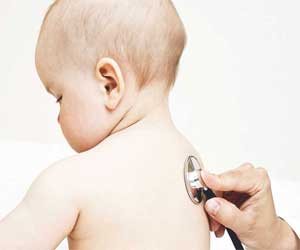- Home
- Editorial
- News
- Practice Guidelines
- Anesthesiology Guidelines
- Cancer Guidelines
- Cardiac Sciences Guidelines
- Critical Care Guidelines
- Dentistry Guidelines
- Dermatology Guidelines
- Diabetes and Endo Guidelines
- Diagnostics Guidelines
- ENT Guidelines
- Featured Practice Guidelines
- Gastroenterology Guidelines
- Geriatrics Guidelines
- Medicine Guidelines
- Nephrology Guidelines
- Neurosciences Guidelines
- Obs and Gynae Guidelines
- Ophthalmology Guidelines
- Orthopaedics Guidelines
- Paediatrics Guidelines
- Psychiatry Guidelines
- Pulmonology Guidelines
- Radiology Guidelines
- Surgery Guidelines
- Urology Guidelines
CPAP can work well even outside Intensive Care Unit in Bronchiolitis

Continuous positive airway pressure (CPAP) has been continuously performed in infants with bronchiolitis on the general paediatrics floors safely outside Intensive Care Unit and without any problems for 20 years now, in the Rady Children’s Hospital in San Diego.
Rady’s hand was forced on the issue because it has a large catchment area but limited Intensive Care Unit beds, so for practical reasons and within certain limits, CPAP moved to the floors
"This is significant considering bronchiolitis CPAP is very rarely performed outside of the Intensive Care Unit. This is due to the perception that there may be some complications and also that keeping a kid on the floor might miss on the ones who are really sick. However, the procedure has been performed safely for such a long time in the hospital that no one gives it a second thought," according to Christiane Lenzen, a pediatric hospitalist at Rady and an assistant clinical professor of paediatrics at the University of California, San Diego.
It doesn’t matter if children have congenital heart disease, chronic lung disease, or other problems, she said, “if they are stable enough for the floor, we will see if it’s okay.”
Rady also has onsite pediatric ICU services for when things head south. Over the past 3 or so years, 52% of the children the pediatric hospital medicine service started on CPAP (168/324) had to be transferred to the ICU; 17% were ultimately intubated.
Many of those transfers were triggered not by CPAP failure but by comorbidities, but other times children needed greater respiratory support. The floor CPAP limit is 6 cm H2O and a fraction of inspired oxygen of 50%. Also, sometimes children needed to be sedated for CPAP, which isn’t done on the floor.
Even so, among 324 children who at least initially were treated with CPAP on the floor – out of 2,424 admitted to the pediatric hospital medicine service with bronchiolitis – there hasn’t been a single pneumothorax, aspiration event, or CPAP equipment-related injury, she said.
CPAP on the floor has several benefits. ICU resources are conserved, patient handoffs and the work of transfers into and out of the Intensive Care Unit are avoided, families don’t have to get used to a new treatment team, and infants aren’t subjected to the jarring ICU environment.
With inputs from The Hospitalist

Disclaimer: This site is primarily intended for healthcare professionals. Any content/information on this website does not replace the advice of medical and/or health professionals and should not be construed as medical/diagnostic advice/endorsement or prescription. Use of this site is subject to our terms of use, privacy policy, advertisement policy. © 2020 Minerva Medical Treatment Pvt Ltd